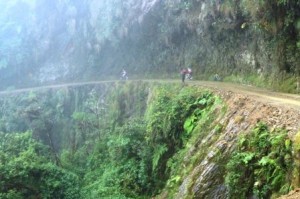 Filed from Bolivia, it’s my account of a cycle down the above-mentioned road. Published in the travel section of Alpha magazine. I never even saw the layout.
Filed from Bolivia, it’s my account of a cycle down the above-mentioned road. Published in the travel section of Alpha magazine. I never even saw the layout.
________
Yes, Bolivia
The Sundance Kid may not have liked Bolivia, but he and Butch were shot 100 years ago. Things have moved on in these here parts since: around La Paz, the world’s highest-altitude capital city, there’s enough serious climbing, hiking, rafting, mountain biking and kayaking to challenge the toughest gunslinger. And, most famously, top of the list, there’s…
The world’s most dangerous road
In 1995, a study by the Inter-American Development Bank (wake up back there) discovered that the road toll on the Yungas Road, 70km down a mountainside from La Paz to Coroico in the Amazonian jungle, made it more lethal than any other trafficked surface on earth. Local trucks simply couldn’t stay away from each other or away from the cliff-edge, and the bodies piled up.
Not long after this announcement, someone (probably a Kiwi) decided that the best thing to do was offer cycle rides down this hell-track. Now it’s the most popular activity in La Paz, apart from wearing silly hats, with more than 40 outfits offering you the chance to tackle the world’s most dangerous road. Only what they don’t want you to know is…
It isn’t any more. A few years ago they built another, better road down the mountain, taking 90 per cent of the traffic away. Oh, with unpaved roads and sheer drops, you can still die; you just won’t do it tangled up in the radiator grill of some dopey Bolivian truck driver.
Going up
An hour’s climbing out of La Paz’s bowl, we unload expensive mountain bikes off the top of a minivan, onto La Cumbre, the raw, wind-blasted top of Bolivia’s altiplano. At 4000m up, there’s a lake, a road, a few clouds and not much else. It’s like Jindabyne, without the friendly cabins or two-thirds of the oxygen. Within minutes I can’t feel my fingers; yet we’ve also brought shorts, T-shirts, sunscreen and insect repellent. In five hours we’ll go through any number of weather conditions, on the way down to 1000m.
Our American guide, Cody, hands out pure alcohol to pour on front wheels as an offering to Mother Earth, Pachamama. And he’s serious. He’s a cool guy, but he’ll do everything to get to the bottom with the same number of riders he started with.
Going Down
We set off, steeply downhill, curving around the mountainside, frosty clouds below us, chugging through rocky valleys, and I’ve forgotten how to ride a bike. Trust the bike, said Cody, but I’m trying to strangle the thing: stiff arms, tight hands. Every time I look down I veer towards danger.
At the first of many stops, we’re shown the wreck of a car far, far below. And there IS traffic: cars and trucks playing chicken with each other and us, along slippery roads with no barriers. Nice commute.
Gradually I loosen up. My arms remember to bend, my body remembers that riding is just riding. About 15 kays along, we’re offered the chance to do something we’ve hardly done so far: pedal. We can either get on the support bus, or try 8km of gentle ups and downs. Sound easy? At this altitude it’s hard work just walking upstairs.
We’re also warned that the weather might be bad, and we eight volunteers ride straight into a dirty cloud. Within seconds my sunnies are drenched; I take them off and my eyes are drenched. I’m near blind, riding a road last paved in Hawke’s first term, and somewhere over there is a fatal drop. Then we hit the first hill. All my energy drains away through my soaking shoes. There’s no air. It’s pathetic, grown men cycling like little girls. Get me a bell and a basket. At the top of the little incline I want to get off and sleep. I struggle on through the rain blasting me in the face.
A long, long time later, the support bus appears ahead in the fog. We stagger out of saddles, broken men. That Lance Armstrong was even better than we thought.
Down and down – no more pedaling – across loose stones and potholes and dicey gravel-tops. The endless twists and turns are hypnotic, which is why Cody keeps up the regular stops. His grim stories plug the overconfidence, too. Here’s a cross for the French girl who stopped near the edge, overbalanced and hopped right off the wrong side of the bike. Here’s another cross for the Israeli guy who didn’t notice that his own group had stopped. Sailed right into space without even touching the brakes. Here’s the marker to mark the end of some opposition leaders a few decades back. Government goons marched them up, applied blindfolds and threw them off at 200m.
It gets warmer and greener and dryer. Waterfalls gush down the cliffs above us. By now, in our filthy Day-Glo jackets, we look like a party of ditch-diggers. Without goggles on, I’m crying tears of mud. Suddenly, like a curtain going up, the clouds are gone and the sun is out. The lush, almost untouched Yungas valley stretches away before us. We can see Coroico town, the end of the road. The last challenge is to ride the last section without touching the brakes at all. Trust that bike.